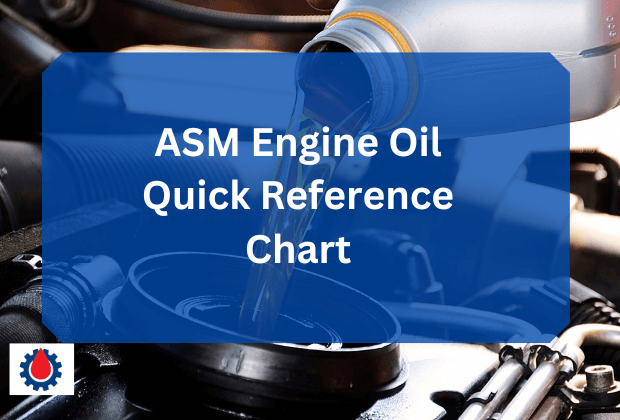The ASM engine oil quick reference chart is a tabular guide developed by ASM (Automotive Service Management) that outlines the recommended engine oil types for different vehicle makes and models. It’s commonly used in workshops and garages to simplify oil selection during servicing.
ASM Engine Oil Quick Reference Chart
| Engine/Equipment Type | Recommended Oil Grade (SAE) | Oil Type | Viscosity | Operating Temp Range | Oil Change Interval | Notes |
|---|---|---|---|---|---|---|
| Lawn Mowers (Push/Riding) | SAE 30 / 10W-30 / 5W-30 | Synthetic/Conventional | Medium/Thin | 40°F and above (SAE 30) 0°F to 100°F (10W-30) | Every 25-50 hours or annually | Use 5W-30 for better cold-starts |
| Tractors (Compact/Utility) | 15W-40 / 10W-30 | Synthetic Diesel Oil | Thick/Medium | -20°F to 120°F+ | Every 100-200 hours | Use CJ-4 or CK-4 certified oils |
| Generators | 10W-30 / 5W-30 | Synthetic | Medium/Thin | -20°F to 100°F | Every 100 hours or seasonally | Check for inverter vs conventional engine |
| ATVs/UTVs | 10W-40 / 5W-40 | Synthetic | Medium | -10°F to 100°F | Every 100 hours or 6 months | Ensure JASO MA/MA2 compatibility |
| Motorcycles (4-stroke) | 10W-40 / 20W-50 | Synthetic Motorcycle Oil | Medium/Thick | 30°F to 120°F | Every 3,000 to 5,000 miles | Use motorcycle-specific oil for wet clutches |
| Diesel Trucks (Light/Heavy Duty) | 15W-40 / 5W-40 | Synthetic Diesel Oil | Thick | -10°F to 120°F+ | Every 5,000 to 10,000 miles | Use API CK-4/CJ-4 compliant oil |
| Gasoline Cars & Trucks | 5W-30 / 0W-20 | Synthetic | Thin | -30°F to 100°F+ | Every 5,000 to 7,500 miles | Check owner’s manual for OEM spec |
| Snowblowers | 5W-30 / 0W-30 | Synthetic | Thin | -30°F to 40°F | Every season or 25 hours | Cold-weather startup protection |
| Pressure Washers | SAE 30 / 10W-30 | Synthetic/Conventional | Medium | 40°F and above | Every season or 50 hours | Avoid multi-viscosity in some pumps |
| Marine Engines (4-stroke) | 10W-30 / 25W-40 | Marine Synthetic Oil | Medium | 30°F to 100°F+ | Every season or 100 hours | Use NMMA FC-W certified oil |
Related Engine Oil Consumption Chart(For All Engine Types)
Specific Vehicle Engine Oil Specifications (2006–2024)
1. Compact & Sedan Models
| Model | Years | Engine | Cyl | Displacement | Oil Type | Capacity (with filter) |
|---|---|---|---|---|---|---|
| Corolla | 2006–2011 | 1ZZ-FE | 4 | 1.8L | N (5W-30) | 4.4 qt |
| 2009–2018 | 2ZR-FE | 4 | 1.8L | N/S (5W-20) or S (0W-20) | 4.4 qt | |
| 2019–2024 | 2ZR-FE (M20A-FKS) | 4 | 2.0L | S (0W-16) | 4.4 qt | |
| Camry | 2006–2011 | 2AZ-FE | 4 | 2.4L | N/S (5W-20) | 4.5 qt |
| 2012–2017 | 2AR-FE | 4 | 2.5L | S (0W-20) | 4.7 qt | |
| 2018–2024 | A25A-FKS | 4 | 2.5L | S (0W-16) | 5.0 qt | |
| Prius | 2006–2015 | 2ZR-FXE | 4 | 1.8L | S (0W-20) | 4.4 qt |
| 2016–2024 | 2ZR-FXE (hybrid) | 4 | 1.8L | S (0W-16) | 4.4 qt |
Related Car Engine Oil Capacity Chart(Car Model A to Z)
2. SUVs & Crossovers
| Model | Years | Engine | Cyl | Displacement | Oil Type | Capacity |
|---|---|---|---|---|---|---|
| RAV4 | 2006–2012 | 2AZ-FE | 4 | 2.4L | N/S (5W-20) | 4.0 qt |
| 2013–2018 | 2AR-FE | 4 | 2.5L | S (0W-20) | 4.7 qt | |
| 2019–2024 | A25A-FKS | 4 | 2.5L | S (0W-16) | 5.0 qt | |
| Highlander | 2006–2013 | 2GR-FE | 6 | 3.5L | N (5W-30) | 6.4 qt |
| 2014–2024 | 2GR-FKS | 6 | 3.5L | S (0W-20) | 6.4 qt | |
| 4Runner | 2006–2009 | 1GR-FE | 6 | 4.0L | N (5W-30) | 5.5 qt |
| 2010–2024 | 1GR-FE | 6 | 4.0L | S (0W-20) | 6.6 qt |
3. Trucks & Full-Size SUVs
| Model | Years | Engine | Cyl | Displacement | Oil Type | Capacity |
|---|---|---|---|---|---|---|
| Tacoma | 2006–2015 | 2TR-FE | 4 | 2.7L | N/S (5W-20) | 6.1 qt |
| 2016–2024 | 2GR-FKS | 6 | 3.5L | S (0W-20) | 6.2 qt | |
| Tundra | 2006–2021 | 3UR-FE | 8 | 5.7L | N/S (5W-20) | 7.4–7.9 qt |
| 2022–2024 | V35A-FTS (TT V6) | 6 | 3.5L | S (0W-20) | 8.0 qt | |
| Sequoia | 2006–2022 | 3UR-FE | 8 | 5.7L | N/S (5W-20) | 7.4–7.9 qt |
| 2023–2024 | V35A-FTS (TT V6) | 6 | 3.5L | S (0W-20) | 8.0 qt |
Related Engine Oil Compatibility Chart(A Detailed Guide)
4. Lexus Models (Common)
| Model | Years | Engine | Oil Type | Capacity |
|---|---|---|---|---|
| RX 350 | 2006–2015 | 2GR-FE | N (5W-30) → S (0W-20) | 6.4 qt |
| 2016–2024 | 2GR-FKS | S (0W-20) | 6.4 qt | |
| GX 460 | 2010–2024 | 1UR-FE | S (0W-20) | 7.9 qt |
| LX 570 | 2006–2021 | 3UR-FE | N/S (5W-20) | 7.4–7.9 qt |
| 2022–2024 | V35A-FTS | S (0W-20) | 8.0 qt |
NOTE:
| Code | Meaning | Change Interval |
|---|---|---|
| S | Synthetic oil only | 10,000 mi / 12 months |
| S !!! | Synthetic oil only (with 5K interval) | 5,000 mi / 6 months |
| N | Non-synthetic (conventional) oil only | 5,000 mi / 6 months |
| N/S | Conventional oil recommended / 0W-20 synthetic oil optional | 5,000 mi / 6 months |
General ASM Oil Change Guidelines
- Always use OEM oil filters (Toyota/Lexus).
- Check dipstick level after filling (some models require overfill for proper lubrication).
- Reset oil maintenance light (if applicable).
- Flex-fuel (E85) vehicles require 2,500-mile oil changes.
- Off-road or heavy towing? Consider 5,000-mile intervals even with synthetic
Related Engine Oil Specification Chart(A to Z Guide)
Benefits of Using the ASM Engine Oil Quick Reference Chart
Saves Time
Mechanics and vehicle owners no longer need to sift through manuals or perform deep dives into spec sheets.
Ensures Accuracy
Ensures the correct oil grade and type is selected, reducing the risk of engine wear or failure.
Improves Engine Performance
Right oil = less friction = better performance. Simple math.
Prevents Warranty Voids
Sticking to the chart means staying within manufacturer guidelines and protecting warranties.
Related Engine Oil Weight Chart(Comprehensive Guide)
Common Mistakes to Avoid When Using the Chart
1. Assuming One Oil Fits All
Even within the same brand, oil requirements differ based on engine type and year.
2. Ignoring Special Notes
Some engines require oils that meet specific standards (like Dexos1 or ACEA C3).
3. Using Incorrect Viscosity
Using 10W-40 instead of the recommended 5W-30 can increase wear and reduce fuel economy.
Related Diesel Engine Oil Grades Chart(Ultimate Guide)
FAQs
Can I use any synthetic oil listed in the ASM chart?
No, only use oils that match the certifications and viscosity listed in the chart.
What happens if I use the wrong oil type?
You risk engine wear, overheating, sludge build-up, and potentially voiding your warranty.
How often should I change my engine oil?
Typically every 5,000 to 7,500 miles, but check your owner’s manual or ASM guidelines.
Does climate affect my oil choice?
Yes. Colder climates require oils that flow better in low temps (like 0W-20).
Related 2 Cycle Engine Oil Mix Chart(For Perfect Performance)
Can I switch from mineral to synthetic oil?
Yes, but do it gradually or during a full oil change. Ensure your engine is compatible.
Is the ASM chart updated regularly?
Yes. ASM updates its chart to include new engines, oil technologies, and certifications.




